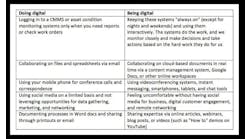The Agile Manifesto in the Industry 4.0 universe
By Ben Gibbs CEO, READY Robotics
In 2001, a small group of seventeen programmers came together and produced the Agile Manifesto for software development. The Agile approach offered an alternative to the traditional waterfall methodology, with the goal of accelerating deployment of new solutions. Organizations across the world have since adopted Agile to great success, from Cisco to LEGO to Phillips. Taking an Agile approach resulted in these companies reducing implementation time on new projects by as much as 70%.
READY Robotics' Ben Gibbs
So how can you apply the key points of the Agile Manifesto to accelerate the adoption of automation and Industry 4.0 technologies on the factory floor? Let’s take a look…
Let cross-functional teams self-organize. Don’t silo your project in an R&D center. Instead find highly motivated individuals from different groups (i.e. production, maintenance, and/or IT) and let them work together to find a solution. Not only will you get better info on which to execute, you’ll improve morale and get more buy-in as people feel involved in the project from the beginning.
<Simplicity is essential. Oftentimes, factories will gravitate toward tackling a complex project because the perceived ROI is massive. Inevitably, the project requires a lot of specialized technology and significant upfront investment, which results in a tremendous amount of planning. In doing so, simple automation projects that result in quick wins get neglected.
Focus on delivering results quickly. Find simple automation tasks and focus on getting them into production as quickly as possible. Instead of trying to automate a complex assembly and inspection task, find a simple machine-tending task that requires basic loading and unloading. Not only will you start to see a ROI from automation right away, you will also build momentum and expertise toward tackling more complex projects down the road. Only once you’ve automated all the quick wins should you focus on more complicated endeavors.
Welcome changing requirements. This is one of the hardest aspects of Agile to implement, especially on the factory floor where automation projects can involve a lot of hardware. The trick is to ensure the changing requirements are limited in scope (e.g. reduce system downtime by adding a stack light to the parts feeder to signal when it’s empty), and not a wholesale overhaul of the entire project.
Meet daily. Make sure your Agile teams hold a daily “stand-up” meeting to discuss new findings and changing requirements. Keep the meeting to no more than 15 minutes (and shorter if possible). Make sure the team also meets with someone from management so everyone is in the loop. This creates a sense of buy-in from top to bottom while ensuring everyone is on the same page.
Meet face-to-face. Nothing beats swapping info with your team in person. Whenever possible, make sure to conduct your standups face to face.
Reflect regularly. The mindset that drives an Agile approach is iterative improvement. Not only on the project, but on your Agile process itself. Set up a regular touchpoint beyond your daily stand-ups for team members to provide feedback on what’s working and what needs improvement.
Some final words of caution: an agile approach won’t work everywhere. There are some projects where a waterfall-based approach makes more sense (like when you’re building out a large automated assembly line).
Try to avoid “boiling the ocean” with aggressive, top-down approaches to rolling out Agile initiatives. Start small and build momentum. Iterate constantly. By taking this approach, we have seen manufacturers (both large and small) implement automation projects on the factory floor in days or weeks instead of months or years (or never).



